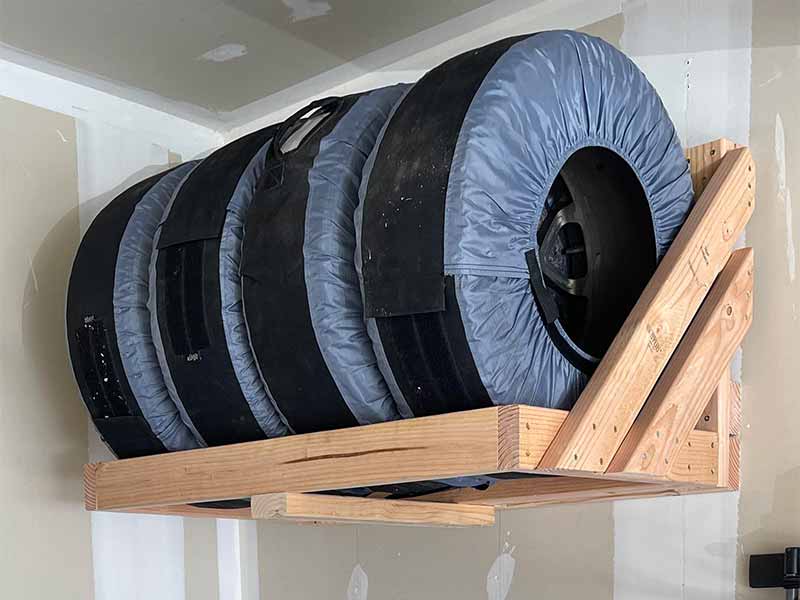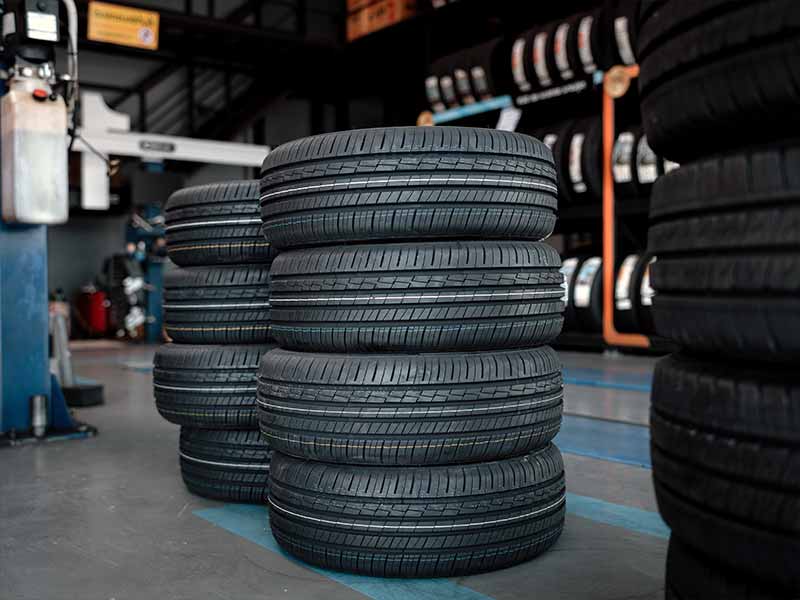Imagine you’re a car enthusiast or homeowner faced with the seasonal tire change. You’ve got a set of tires and nowhere to put them. Storing them right can save you money, space, and hassle. But should they be standing tall or lying flat? Your choice can significantly affect their lifespan and your safety.
Should You Store Tires Vertically Or Horizontally?
For tire longevity and space efficiency, vertically storing tires is often preferred for mounted tires, while horizontal or stacked storage is ideal for unmounted tires. Each method has specific benefits and precautions.
In this article, we discuss the best methods for storing tires, considering factors like space, tire type, and longevity. We’ll explore the advantages and drawbacks of vertical and horizontal storage, provide practical tips for each method, and highlight special considerations for mounted and unmounted tires.

Vertically Store Tires
When it comes to storing tires, the orientation matters. Vertical storage, or storing tires in the same orientation they’d be while mounted on a vehicle, is a popular option. But, like any storage method, it has its pros and cons. Let’s break it down so you can decide if it’s the right choice for your tires.
Advantages of Vertical Storage
- Space Efficiency: Vertical storage is a space saver, especially important for those with limited storage area.
- Maintains Shape: When properly supported, vertically stored tires tend to maintain their shape better over time compared to some other methods.
Drawbacks of Vertical Storage
- Risk of Tipping: Unless secured on a rack or with some support system, vertically stored tires can be prone to tipping over.
- Support Requirement: You’ll need a proper rack or shelving system to ensure the tires remain upright and stable.
Tips for Proper Vertical Storage
- Use a Tire Rack: Invest in a quality tire rack that can securely hold the tires upright. Ensure it’s installed correctly and can bear the weight of your tires.
- Avoid Direct Contact with Floor: If possible, keep the tires off the ground to prevent moisture absorption and temperature fluctuations from the floor.
- Keep Them Clean: Before storing, clean each tire to remove dirt and grime. This helps prevent degradation linked to contaminants.

Stacked Tires Cover
Horizontally Store Tires
Alternatively, horizontal storage means laying the tires flat on their sidewalls. It’s another valid method, especially for unmounted tires, with its own set of considerations.
Benefits of Horizontal Storage
- Even Weight Distribution: Laying tires flat can distribute their weight evenly, reducing the risk of developing flat spots or distortions.
- Easier Handling: It’s often easier to stack and move tires when they’re lying flat, especially for heavier or larger tires.
Disadvantages of Horizontal Storage
- Space Requirements: It typically requires more floor space compared to vertical storage, especially if you’re stacking multiple sets of tires.
- Potential for Moisture Damage: If not properly elevated or protected, laying tires directly on the ground can expose them to moisture and lead to premature aging.
Doing it Right: Horizontal Storage Best Practices
- Use Protective Layers: Place a barrier between the tires and the floor, such as wood pallets or cardboard, to minimize moisture transfer.
- Stack Carefully: If stacking tires horizontally, do it carefully to avoid uneven pressure and potential shape distortion. Regularly rotate the tires in the stack to distribute pressure evenly.
- Limit Stack Height: Don’t stack tires too high. A manageable, safe height ensures the stack remains stable and reduces the risk of the bottom tires deforming under weight.

Tire Storage Dolly
Stacking Horizontally
Stacking tires horizontally, laying flat on their sidewalls, is a common approach, especially when dealing with multiple sets of tires. While this method can be space-efficient and beneficial for the tires’ shape, it’s important to do it correctly to avoid any damage. Let’s unpack the best way to stack your tires for long-term storage.
The Art of Stacking
- Even Surfaces: Ensure that the floor or shelf where the tires will be stacked is even and clean. Uneven surfaces can cause pressure points and deform the tires over time.
- Proper Alignment: Align the tires carefully as you stack them. Misaligned tires can lead to uneven pressure distribution and potential warping.
Pros of Stacking Horizontally
- Space-Saving: When done correctly, stacking tires horizontally can save a considerable amount of space.
- Accessibility: It’s relatively easy to remove one tire at a time from a horizontal stack, making it convenient for those who need to switch between sets seasonally.
Cons of Stacking Horizontally
- Weight Pressure: The weight of the tires on top can distort the tires at the bottom if the stack is too high or left undisturbed for too long.
- Risk of Toppling: A poorly constructed stack can be unstable and risk toppling over, especially if bumped or if the tires are not uniformly sized.
Best Practices for Horizontal Stacking
- Limit Stack Height: To prevent the bottom tires from deforming, limit the height of your stack. A general guideline is to not stack more than four tires high.
- Rotate the Stack: Periodically rotate the tires in the stack to ensure that the same tire isn’t always bearing the load.
- Use Separators: Consider placing a piece of cardboard or plywood between each tire to distribute weight more evenly and prevent any rubber-to-rubber sticking or staining.

Tire Storage Covers
Storing Tires Mounted on Wheels
Many people store their tires mounted on wheels, particularly for seasonal changes like winter and summer tires. The storage method differs slightly from storing tires alone due to the added weight and structure of the wheel.
Advantages of Storing Mounted Tires
- Convenience: Storing tires already mounted on wheels makes the swapping process quicker and easier.
- Protection: The wheel provides some structural integrity and can help maintain the tire’s shape.
Considerations for Mounted Tires
- Weight Factor: The added weight of the wheel requires stronger support systems, whether you’re stacking or using racks.
- Orientation Matters: When storing tires mounted on wheels, you still need to consider vertical vs. horizontal storage and choose the method that best suits your space and preserves the tires.
Tips for Storing Mounted Tires
- Use a Rack: A sturdy rack is ideal for storing mounted tires vertically. Ensure it’s rated for the weight you’ll be placing on it.
- Avoid Hanging: While some might suggest hanging mounted tires, it’s generally better to avoid this as the weight can distort the tire where it contacts the hook or support.
- Keep Them Inflated: Maintain proper inflation even when in storage to help the tires hold their shape and prevent flat spots.

Tire Storage Rack
Storing Unmounted Tires
When it comes to storing unmounted tires, the focus shifts slightly. Without the rims, the tires are more prone to shape distortion and other storage-related stresses. However, with the right approach, you can keep them in excellent condition until they’re needed again. Here’s how to handle your unmounted tires with care.
Importance of Proper Storage for Unmounted Tires
- Vulnerability to Damage: Unmounted tires are more susceptible to environmental factors and physical distortions.
- Flexibility in Storage Options: Without the added bulk and weight of the rims, you have more flexibility in how and where you store them.
Best Practices for Unmounted Tires
- Clean Thoroughly: Remove any dirt, stones, or debris from the tread and sidewalls before storage. This prevents degradation linked to contaminants.
- Store in a Cool, Dry Place: Like all tires, unmounted ones should be kept in an environment that’s cool, dry, and away from direct sunlight or strong artificial light.
- Avoid Folding or Bending: Ensure that the tires retain their natural shape. Don’t stack other items on top of them, and avoid positions that could fold or bend the tire.

General Best Practices for Tire Storage
Whether you’re storing mounted or unmounted tires, some universal rules apply. Following these guidelines will help ensure that your tires remain in good shape, no matter how long they’re stored.
Keep Them Clean
- Before Storing: Wash off any dirt, brake dust, or road salts. Allow them to dry completely to avoid trapping moisture.
- During Storage: Periodically check and wipe down the tires to prevent dust accumulation.
Environment is Key
- Temperature: Store your tires in a cool, not freezing, environment. Consistent, moderate temperatures are ideal.
- Humidity: Avoid areas with high humidity that can accelerate rubber degradation. A dehumidifier can help in damp areas.
- Light: Keep tires away from direct sunlight and intense artificial light, both of which can degrade rubber over time.
Protect the Tires
- Covers: Use tire bags or specially designed covers to shield the tires from dust, moisture, and light.
- Elevation: Keep tires off the ground, preferably on racks or shelves, to protect them from moisture and temperature changes.
Regular Inspection
- Check for Damage: Look for any signs of cracking, dry rot, or other damage, especially if they’ve been stored for an extended period.
- Air Pressure: For mounted tires, check the air pressure and adjust it to the recommended level before storage.
Resources
Below are some links you may find helpful when learning about tires:
- How to store tires to prevent dry rotting and extend their life – Life Storage
- Tire storage tips – Goodyear
Final Thoughts
When it comes to storing tires, both vertical and horizontal methods have their place. Vertical storage is great for saving space and is often used for tires that are still mounted on rims. In contrast, horizontal storage, especially when tires are stacked properly with care, can be better for unmounted tires. Whichever method you choose, remember the importance of a cool, dry environment, away from direct sunlight, and regular inspections to ensure your tires remain in road-worthy condition. With the right approach, you can extend the life of your tires and ensure they’re ready to roll when you are.
Good luck and happy motoring.




